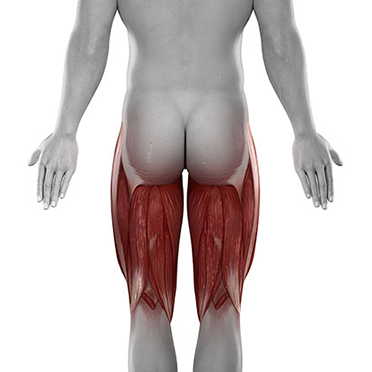Hamstring injury & pain in the hamstring muscles can come from so may different problems, one of them is an injury to the hamstring muscles, but there are so many causes for pain at the back of your thigh therefore its important to understand the differences between a hamstring muscle strain, tear, rupture, pull or tendinitis. This is what we do.
The hamstring muscles, at the back of the thigh, are infamous for being too tight. Right through from the most bendy dancer doing her splits, to the park runner rubbing his thigh after running up the hill, we would all like a little, or a lot, more flexibility from our hamstrings.
The hamstrings are a group of three muscles at the back of the thigh, starting from the sit bone (ischium), gracefully running down the thigh to attach on either side of the knee. Each of the three individual muscles are susceptible to strains, tears or complete ruptures and usually become injured or torn due to overstretching or overuse. A hamstring injury can vary in severity, from fairly minor bruises (contusions) due to a direct blow to the muscle, or to more serious stretches or pulls (strains).
What are the Hamstrings made up of?
On the outside of the leg lies the Bicep Femoris muscle (Bicep-meaning two heads) and on the inside two muscles called Semimembranosus (more membrane) and Semitendinosus (more tendon) muscles. The inner hamstring muscles contract more when your leg is turned outwards, and the outside muscles when the leg is turned inwards.

What do the hamstrings do?
The hamstrings bends your knee, moving your ankle to your hip and pulls your thigh backwards from the hip joint, so just lifting your foot to kick your buttock contracts your hamstring muscles. They work hard when you run up stairs or ascending a hill. It gives us that forward propulsion and push off we need to ascend a stair or push away from the ground to take a step.
The hamstrings contract when you extend the hip backwards and bend the knee to your buttocks therefore any injury to the hamstring muscles will definitely impact your ability to walk or run.
What could hamstring pain also be?
Tendinitis of the Hamstring tendons
Tendinitis of the hamstring tendon would present as pain over the sit bone. The pain is usually worse after long periods of sitting or driving, or using the muscle with the hip bent, like doing deep lunges, a lot of stretches, or increasing your running speed or hill training. The pain may be felt at the start of exercise and then disappear as the body warms, only to return after you have cooled down.
Iliotibial band Syndrome (ITB Syndrome)
The Hamstrings have some anchors on the outside to the Iliotibial band. In this case your pain will be more towards the outside of the thigh and usually travels all the way to the outside of the knee with a very tender spot on the outside of the knee. ITB Syndrome can be confused with a hamstring injury.
Peripheral nerve entrapment of the Sciatic nerve
The sciatic nerve is the supply chain of nerves for the leg. The nerve can become pinched along it’s way down the back of your leg usually by scar tissue from previous injury. Even if you only had a fairly minor hamstring injury. Your pain may be limited to the back of the thigh or spread below the knee, depending on the branches of the nerve that are entrapped. The pain will have a tingling quality, you may experience pins and needles, numbness or weakness.
Femur stress fracture
Repetitive strain and excessive training may cause a stress fracture of the thigh bone (femur). This would be suspected if the pain is more a dull and constant, irrespective of rest or walking around. Stress fracture may not be visible on normal X-rays, so referral to an Orthopaedic surgeon may be necessary to request either an MRI or CT-scan. This type of pain usually gets worse when you lay on your side, and may wake you up at night.
Knee Ligament injury (posterior cruciate ligament tear)
Injury to PCL ligament at the back of the knee. You will feel pain at the back of your knee where the hamstring muscle group split to attach to either side below the knee. The mechanism of injury or what aggravates your pain would lead us to look elsewhere to find the source of your symptoms.
Lumbar referred pain
Lower back pain may refer down to the hamstring area. This may be due to disc pathology, arthritis or facet joint strain. If your pain is referred from the lower back you would have experienced some kind of back ache leading up to your symptoms.
Calf muscle tear
May patient mistake a Hamstring injury as a Gastrocnemius muscle tear or strain, where the pain is more in the fold at the back of the knee, because the Gastrocnemius muscles that folds underneath the hamstring, you may feel more pain when straightening your knee.

